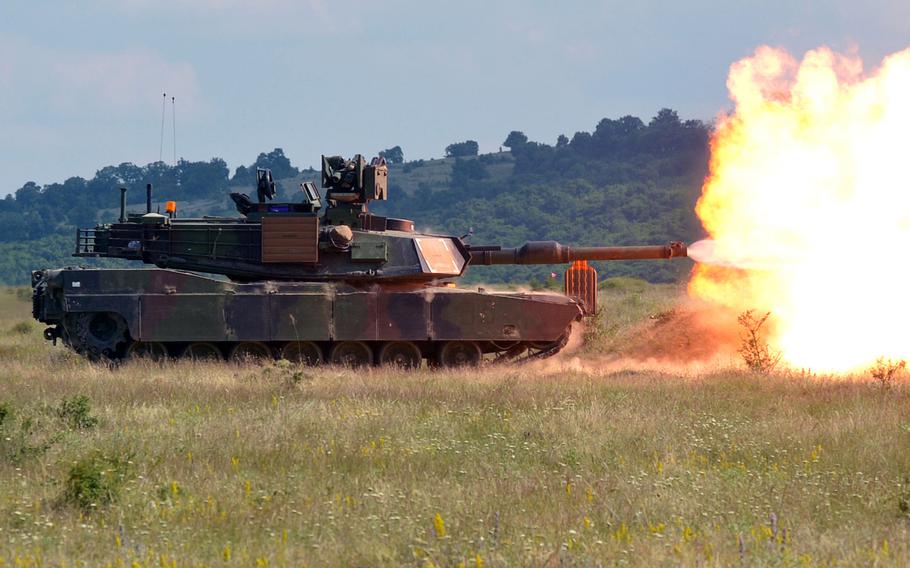Europe
Who’s sending what to Ukraine: A new wave of Western weapons explained
The Washington Post February 2, 2023

An M1A2 Abrams tank assigned to the 3rd Infantry Division fires a practice round at the Novo Selo Training Area in Bulgaria in 2015. (Michael Abams/Stars and Stripes)
A new surge of increasingly elaborate weapons from Western countries could change the balance on the battlefield in Ukraine as Kyiv’s major backers agree to successive requests that once made them balk.
Control of terrain and fighting conditions have shifted in recent months, with Ukraine’s allies recalibrating their concerns of broader escalation with Russia. Ukraine has ramped up its calls for aid, building on the trust it gained in fighting with the Western weapons that dominated its requests earlier in the war, including Javelin antitank missiles, drones and High Mobility Artillery Rocket System (HIMARS) launchers.
From tanks to air defense systems, the U.S.- and European-made weapons are expected to complement or replace largely Soviet-era technology in use by Ukrainian forces and allow them to use ammunition manufactured in the West. The deliveries could provide a significant advantage to Kyiv, though experts warn that technical and logistical hurdles still must be overcome.
Here’s a guide to some of the key weapons and vehicles that Ukraine’s allies have recently agreed to send.
1. United States
Amid a push to arm Ukraine with more modern tanks, the United States announced plans in January to send 31 M1A2 Abrams tanks. The U.S. main battle tank, the original version of which entered service in 1980, is considered among the world’s most powerful. Updates include layers of depleted uranium armor that provide increased protection to the crew inside.
The Biden administration previously warned that the U.S.-made tanks could present maintenance and training difficulties for Ukraine, noting that the multi-fuel engine usually runs on jet fuel, which could be difficult to supply. The United States also promised in January to supply two types of armored vehicles to Ukraine: 90 Stryker armored personnel carriers and 109 Bradley Fighting Vehicles. The Washington Post in 1991 described the Bradley as “half tank, half taxi.” A tracked vehicle, it is designed to move and support foot soldiers and can be equipped with an antitank missile launcher.
Strykers, which are wheeled vehicles, are designed to move soldiers more quickly, with the most common variant able to carry a squad of nine along with a driver and vehicle commander. They have lighter armor and weaponry than the Bradley and the Abrams and can get stuck in muddy conditions.
In December, Washington also agreed to give Ukraine one Patriot air defense battery. At an estimated cost of roughly $1 billion, the surface-to-air guided missile system can track and target enemy weapons such as ballistic missiles.
2. Germany
On the same day the United States declared it would send the Abrams tanks, Germany said it would deliver 14 Leopard 2A6 main battle tanks from its own stocks to Ukraine.
The decision followed debate among allies over the German-made tanks, which are widely exported in Europe. Berlin has the final say over reexport authorization, and German officials had been reluctant to dispatch Leopards unless the United States also pledged to send Abrams tanks.
More than 2,000 Leopard tanks are owned by armies across Europe, according to the International Institute for Strategic Studies. Germany has said it will allow other countries, such as Poland, Norway and Spain, to send their own Leopard tanks, with the goal of assembling two battalions in Ukraine.
The Leopard 2 has since been upgraded since its introduction in 1979, gaining a reputation as one of the world’s best main battle tanks. It has a diesel engine, and its newer models are not as heavy as the latest U.S. Abrams tanks.
3. Poland
One of the countries that urged Germany to release the Leopard tanks, Poland has pledged to send 14 of its own.
Poland has already supplied older, Soviet-era tanks. Its prime minister said in January that his country, which borders Ukraine to the west, sent nearly 250 tanks earlier in the war.
Warsaw has also announced it will deliver 30 PT-91 Twardy tanks, a modernized version of the Soviet-era T-72 that uses almost entirely domestically produced components.
4. France
French President Emmanuel Macron announced in January that the country would send its AMX-10 RC armored vehicles. Though it is sometimes called a “light tank,” the AMX-10 RC runs on wheels rather than tracks and lacks the same protection as tanks. It can move fast, however, and its large cannon has given it a reputation as a “tank killer.” It was mostly designed for reconnaissance missions during the Cold War, and France is planning to phase it out.
France is also expected to supply another type of armored vehicle: Bastion armored personnel carriers. These modern four-wheel-drive vehicles are meant primarily to move troops around and can accommodate up to eight infantrymen.
Late last year, France agreed to supply Ukraine with two Crotale air defense batteries: all-weather, short-range surface-to-air missile systems that may be particularly useful for intercepting Russian cruise missiles.
5. Britain
In early January, Britain became the first country to pledge Western heavy battle tanks, offering 14 Challenger 2 tanks. While among the most modern tanks that will be available to Ukraine, this British-made tank is considered particularly heavy.
Britain also announced it would send AS90 self-propelled artillery systems to Ukraine. These howitzers, produced in the 1990s for the British army and used in the Iraq War, are close to being replaced within Britain but could provide significant support to tanks and infantry with relatively long-range fire.